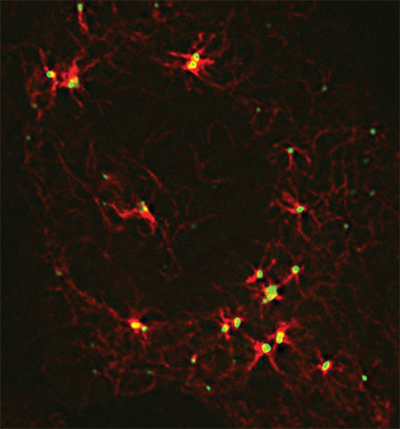JBC: A shadowy organizational hub in cells
On a cellular level, we are all hanging on by delicate threads. All cells are crisscrossed by a network of strands called microtubules, which act as railroad tracks that move cargo around the cell, as winch cables that separate chromosomes during cell division and as scaffolding components that give a cell its shape.
Because of its essential role in the cell cycle, microtubule assembly is the target of essential anti-cancer chemotherapies (paclitaxel, for example), which stop out-of-control cell division by destabilizing microtubules. Now, researchers have shed light on the role that a large, enigmatic protein plays in assembling microtubules, paving the way for better treatments. The results of the research in the Journal of Biological Chemistry.
 A large protein coordinates cellular components required for microtubule assembly.Courtesy of James Goldenring, Vanderbilt University
A large protein coordinates cellular components required for microtubule assembly.Courtesy of James Goldenring, Vanderbilt University
In 1999, research team at Vanderbilt University showed that protein kinase A-anchoring protein 350, or AKAP350, is a component of the centrosome, a center of microtubule organization in human cells. The team later showed that microtubules did not form efficiently without AKAP350. But the way in which AKAP350 regulated microtubule formation was difficult to understand, largely because of the technical challenges posed by AKAP350’s heft.
“Since this protein is so huge, it’s very difficult to study it,” said , the research scientist in Goldenring’s laboratory who led the new study. “A few years ago, we finally came to develop synthetic constructs of (AKAP350), which allowed us to go to the next level of evaluation and function.”
Using a combination of detailed biochemical analyses and super-resolution microscopy, the team finally was able to gain some understanding of the complex roles that AKAP350 plays in regulating microtubules in cells. AKAP350 formed a physical bridge spanning components of the centrosome. And AKAP350 appeared to recruit multiple proteins involved in building microtubules, coordinating their function in one spot.
“I like to call this thing Deep Space Nine. Everybody comes to hang out at AKAP350,” Goldenring said. “I think we’ve only scratched the surface of the structural organization that this protein is probably providing.”
Mutations in AKAP350 have been associated with cardiac arrhythmias, so it will be of interest to see whether the protein’s role in microtubule assembly contributes to proper heart function as well.
“I think (AKAP350) is a fundamental regulator of cell function,” Goldenring said. “So we need to know a lot more about this protein before we can even begin looking at what it might mean for disease.”
Enjoy reading 91—«…´¥´√Ω Today?
Become a member to receive the print edition four times a year and the digital edition monthly.
Learn moreGet the latest from 91—«…´¥´√Ω Today
Enter your email address, and we’ll send you a weekly email with recent articles, interviews and more.
Latest in Science
Science highlights or most popular articles

Bacterial enzyme catalyzes body odor compound formation
Researchers identify a skin-resident Staphylococcus hominis dipeptidase involved in creating sulfur-containing secretions. Read more about this recent Journal of Biological Chemistry paper.

Neurobiology of stress and substance use
MOSAIC scholar and proud Latino, Bryan Cruz of Scripps Research Institute studies the neurochemical origins of PTSD-related alcohol use using a multidisciplinary approach.

Pesticide disrupts neuronal potentiation
New research reveals how deltamethrin may disrupt brain development by altering the protein cargo of brain-derived extracellular vesicles. Read more about this recent Molecular & Cellular Proteomics article.

A look into the rice glycoproteome
Researchers mapped posttranslational modifications in Oryza sativa, revealing hundreds of alterations tied to key plant processes. Read more about this recent Molecular & Cellular Proteomics paper.

Proteomic variation in heart tissues
By tracking protein changes in stem cell–derived heart cells, researchers from Cedars-Sinai uncovered surprising diversity — including a potential new cell type — that could reshape how we study and treat heart disease.

Parsing plant pigment pathways
Erich Grotewold of Michigan State University, an 91—«…´¥´√Ω Breakthroughs speaker, discusses his work on the genetic regulation of flavonoid biosynthesis.

.jpg?lang=en-US&width=300&height=300&ext=.jpg)